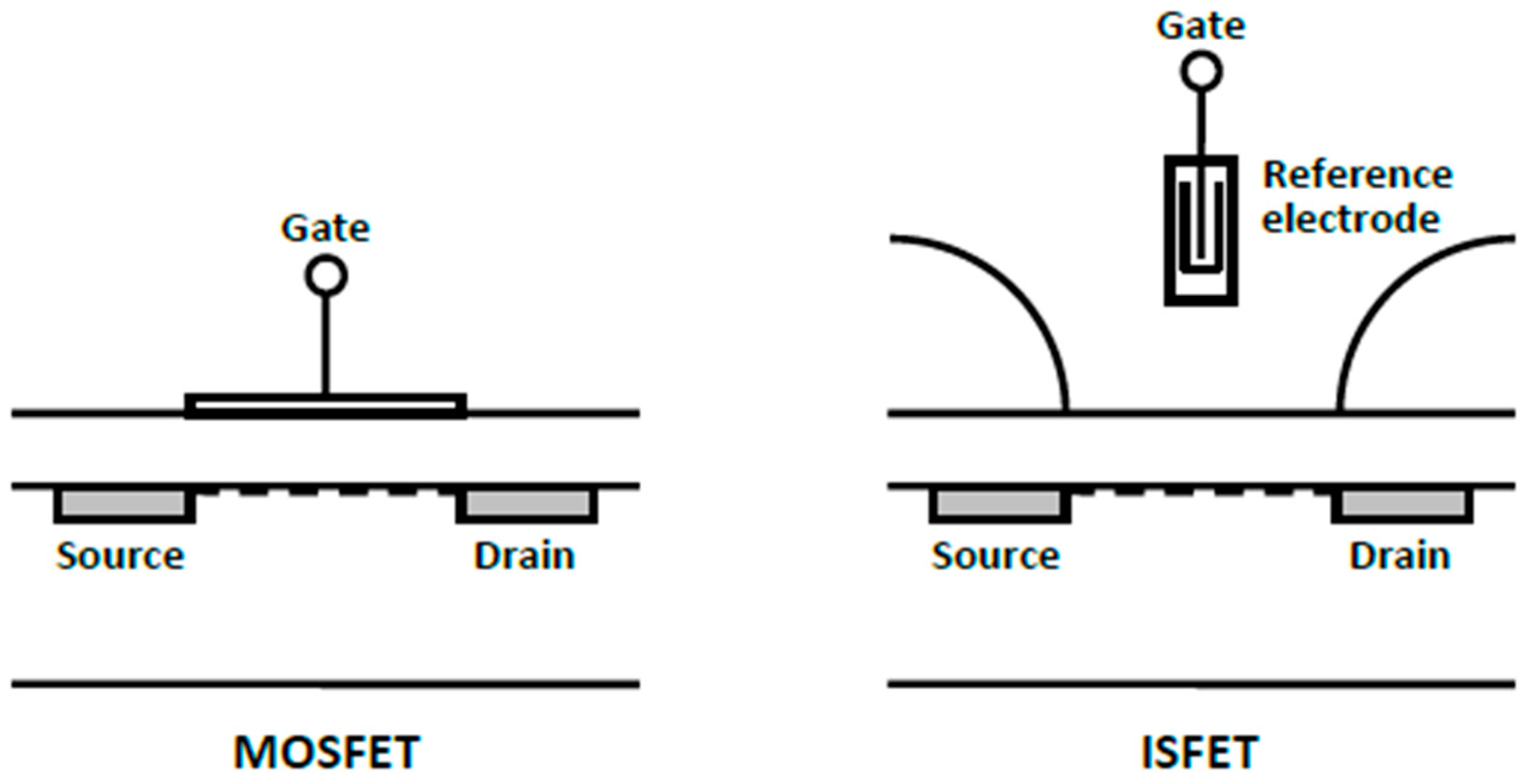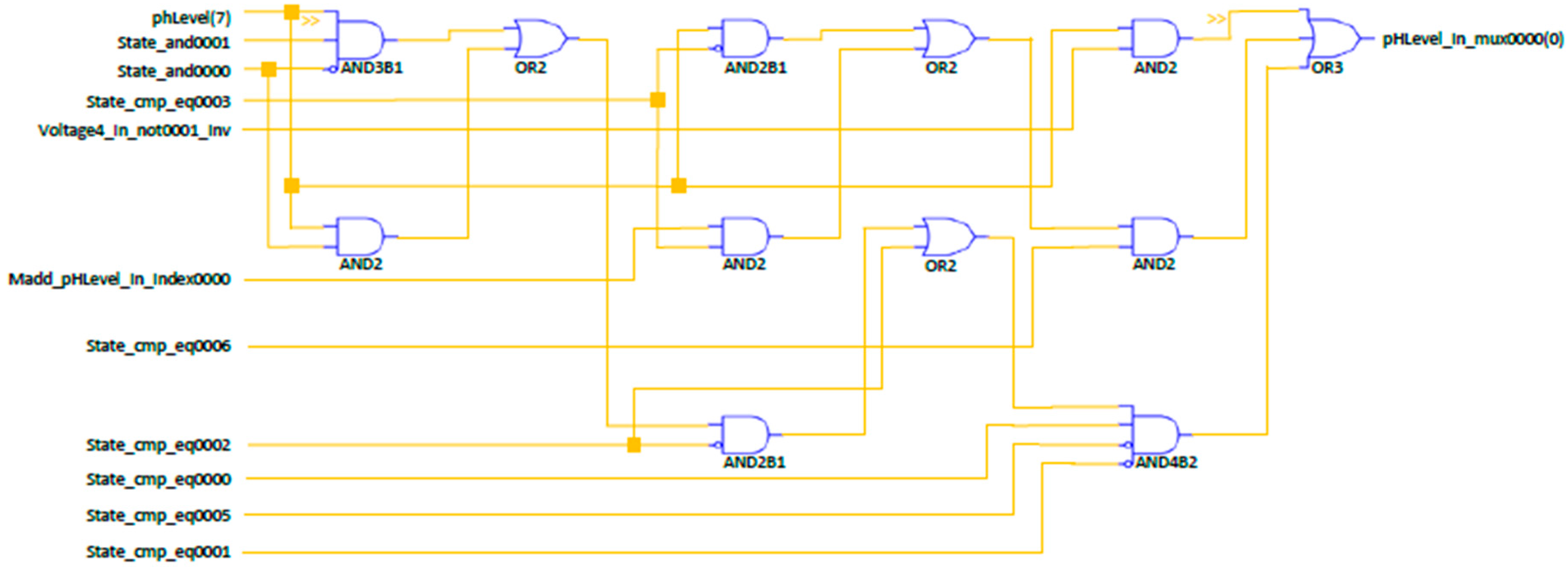Characterization of an ISFET with Built-in Calibration Registers through Segmented Eight-Bit Binary Search in Three-Point Algorithm Using FPGA †
Abstract
:1. Introduction
2. Background, Related Literature and Studies
2.1. Ion-Sensitive Field-Effect Transistor (ISFET)
2.2. pH Level
2.3. Calibration
2.4. Two-Point Calibration Algorithm (Bi-Section Method)
3. Methodology
3.1. Measure Module Algorithm
3.2. Calibration Module Algorithm
3.3. Three-Point Calibration Algorithm
3.4. Register-Transfer Level (RTL)
3.5. Schematic Diagram
4. Test and Results
5. Conclusions
Acknowledgments
Author Contributions
Conflicts of Interest
References
- Chung, W.Y.; Yang, C.H.; Wang, Y.F.; Chan, Y.J.; Torbicz, W.; Krzyskow, A. A Signal Processing ASIC for ISFET-Based Chemical Sensors. Microelectron. J. 2004, 35, 667–675. [Google Scholar] [CrossRef]
- Chung, W.Y.; Chang, J.P.; Cruz, F.R. Clock-Gated and Low-Power Standard Cell Library for ISFET Two-Point Calibration Processor Chip. In Proceedings of the 2010 IEEE Asia Pacific Conference on Circuits and Systems, Kuala Lumpur, Malaysia, 6–9 December 2010. [Google Scholar] [CrossRef]
- Guerrero, E.; Sanz, M.T.; Molina-Reyes, J.; Medrano-Marqués, N.J.; Calvo, B.; Antolín, D. Programmable Calibration Circuit for MIM-ISFET Device. In Proceedings of the 2012 IEEE International Instrumentation and Measurement Technology Conference, Graz, Austria, 13–16 May 2012. [Google Scholar] [CrossRef]
- Abbasi, A.Z.; Islam, N.; Shaikh, Z.A. A Review of Wireless Sensors and Networks’ Applications in Agriculture. Comput. Stand. Interfaces 2014, 36, 263–270. [Google Scholar]
- Simbeye, D.D.; Yang, S.F. Water Quality Monitoring and Control for Aquaculture Based on Wireless Sensor Networks. J. Netw. 2014, 9, 840–849. [Google Scholar] [CrossRef]
- Chung, W.Y.; Lin, Y.T.; Pijanowska, D.G.; Yang, C.H.; Wang, M.C.; Krzyskow, A.; Torbicz, W. New ISFET Interface Circuit Design with Temperature Compensation. Microelectron. J. 2006, 37, 1031–1146. [Google Scholar] [CrossRef]
- Hu, Y.Q.; Li, J.D.; Georgiou, P. A SAR Based Calibration Scheme for ISFET Sensing Arrays. In Proceedings of the 2014 IEEE International Symposium on Circuits and Systems (ISCAS), Melbourne, Australia, 3–6 August 2014. [Google Scholar] [CrossRef]
- Chung, W.Y.; He, F.S.; Yang, C.H.; Wang, M.C. Drift Response Macromodel and Readout Circuit Development for ISFET and Its H+ Sensing Applications. J. Med. Biol. Eng. 2006, 26, 29–34. [Google Scholar]
- Zinal Abidin, M.A.B.; Zolkapli, M.; Mohammad Noh, N.I.; Abdullah, W.F.H. Data Acquisition for ISFET pH Sensor System by Using Seeeduino Stalker as a Controller. In Proceedings of the 2013 IEEE 4th Control and System Graduate Research Colloquium, Shah Alam, Malaysia, 19–20 August 2013. [Google Scholar] [CrossRef]
- O’Haver, T. Interactive Computer Models for Analytical Chemistry Instruction. Available online: https://terpconnect.umd.edu/~toh/models/index.html (accessed on 13 July 2017).
- Myers, A. Calibration of a Non-Linear Sensor. U.S. Patent 5,369,603, 29 November 1994. [Google Scholar]
- Bergveld, P. ISFET, Theory and Practice. In Proceedings of the IEEE Sensor Conference, Toronto, ON, Canada, October 2003; Available online: http://www.idc-online.com/technical_references/pdfs/mechanical_engineering/ISFET-Bergveld.pdf (accessed on 13 July 2017).
- Jaffrezic-Renault, N.; Senillou, A.; Martelet, C.; Wan, K.; Chovelon, J.M. ISFET Microsensors for the Detection of Pollutants in Liquid Media. Sens. Actuators B: Chem. 199, 59, 154–164. [Google Scholar] [CrossRef]
- Casans, S.; Muñoz, D.R.; Navarro, A.E.; Salazar, A. ISFET Drawbacks Minimization Using Novel Electronic Compensation. Sens. Actuators B: Chem. 2014, 99, 42–49. [Google Scholar] [CrossRef]
- Miao, Y.Q.; Chen, J.R.; Fang, K.M. New Technology for the Detection of pH. J. Biochem. Biophys. Methods 2005, 63, 1–9. [Google Scholar]
- Ṕerez, J.F.V.; Velasco, M.M.M.; Rosas, M.E.M.; Reyes, H.L.M. ISFET Sensor Characterization. Sci. Direct Procedia Eng. 2012, 35, 270–275. [Google Scholar] [CrossRef]
- pH Chemistry. In Encyclopedia Britannica; Encyclopedia Britannica Inc.: Edinburgh, UK, 2017.
- Wockenfus, A.M.; Koch, C.D.; Conlon, P.M.; Sorensen, L.D.; Cambern, K.L.; Chihak, M.J.; Zmolek, J.A.; Petersen, A.E.; Burns, B.E.; Lieske, J.C.; et al. Discordance between Urine pH Measured by Dipstick and pHmeter: Implications for Methotrexate Administration Protocols. Clin. Biochem. 2010, 46, 152–154. [Google Scholar] [CrossRef] [PubMed]
- Burden, R.; Faires, J.D. Numerical Analysis, 9th ed.; Brooks/Cole Cengage Learning: Boston, MA, USA, 2001. [Google Scholar]
- Springer, E. pH Measure Guide; Hamilton Company: Reno, NV, USA, 2006; Available online: http://www.hamiltoncompany.com (accessed on 13 July 2017).
- Bhasker, J. A Verilog HDL Primer, 2nd ed.; Star Galaxy Publishing: Allentown, PA, USA, 1999. [Google Scholar]






| Target Buffer Solution (25 °C) | Radiometer PHM290 (2-Point Cal) | Sentron Argus (2-Point Cal) | The Proposed ASIC (2-Point Cal) | |||
|---|---|---|---|---|---|---|
| Measured pH | Error ΔpH | Measured pH | Error ΔpH | Measured pH | Error ΔpH | |
| pH 2.00 | 1.94 | −0.06 | 1.89 | −0.11 | 2.03 | 0.03 |
| pH 4.00 | 3.96 | −0.04 | 3.98 | −0.02 | 4.04 | 0.04 |
| pH 6.00 | 6.01 | 0.01 | 5.99 | −0.01 | 5.99 | −0.01 |
| pH 8.00 | 7.91 | −0.09 | 7.93 | −0.07 | 7.89 | −0.11 |
| pH 10.00 | 9.77 | −0.23 | 9.81 | −0.19 | 9.76 | −0.24 |
| pH 12.00 | 11.73 | −0.27 | 11.93 | −0.07 | 11.87 | −0.13 |
| pH | 8-bit Assignment |
|---|---|
| 4 | 0000 0000 |
| 7 | 0111 1111 |
| 10 | 1111 1110 |
| Expected pH | Voltage Unknown (Vrout) in mV | Calculated pH | %Error | ||
|---|---|---|---|---|---|
| Decimal | Binary | Output (pH) | |||
| 4 | 173.4302745 | 254 | 1111 1110 | 4 | 0 |
| 5 | −114.5320784 | 210 | 1101 0010 | 5.03937 | 0.78124845 |
| 6 | −57.00360781 | 168 | 1010 1000 | 6.031496 | 0.52219217 |
| 7 | 0.52486277 | 127 | 0111 1111 | 7 | 0 |
| 8 | 59.42305884 | 83 | 0101 0011 | 8.030937 | 0.48971499 |
| 9 | 116.9515294 | 41 | 0010 1001 | 9.031496 | 0.34873514 |
| 10 | 174.48 | 0 | 0000 0000 | 10 | 0 |
| Expected pH | pH in 3-Point | pH in 2-Point |
|---|---|---|
| 4 | 4.04 | 4.04 |
| 5 | 4.188976 | 4.11811 |
| 5 | 4.377953 | 4.30709 |
| 5 | 4.661417 | 4.59055 |
| 5 | 4.944882 | 4.89764 |
| 6 | 6 | 5.99 |
| 8 | 7.566929 | 7.566929 |
| 8 | 7.92 | 7.89 |
| 8 | 8.03937 | 8.06299 |
| 8 | 8.464567 | 8.48819 |
| 9 | 9.102362 | 9.14961 |
| 9 | 9.338583 | 9.40945 |
| 10 | 9.78 | 9.76 |
© 2017 by the authors. Licensee MDPI, Basel, Switzerland. This article is an open access article distributed under the terms and conditions of the Creative Commons Attribution (CC BY) license (http://creativecommons.org/licenses/by/4.0/).
Share and Cite
Manlises, C.O.; Cruz, F.R.; Chung, W.-Y.; Paglinawan, A. Characterization of an ISFET with Built-in Calibration Registers through Segmented Eight-Bit Binary Search in Three-Point Algorithm Using FPGA. J. Low Power Electron. Appl. 2017, 7, 19. https://doi.org/10.3390/jlpea7030019
Manlises CO, Cruz FR, Chung W-Y, Paglinawan A. Characterization of an ISFET with Built-in Calibration Registers through Segmented Eight-Bit Binary Search in Three-Point Algorithm Using FPGA. Journal of Low Power Electronics and Applications. 2017; 7(3):19. https://doi.org/10.3390/jlpea7030019
Chicago/Turabian StyleManlises, Cyrel Ontimare, Febus Reidj Cruz, Wen-Yaw Chung, and Arnold Paglinawan. 2017. "Characterization of an ISFET with Built-in Calibration Registers through Segmented Eight-Bit Binary Search in Three-Point Algorithm Using FPGA" Journal of Low Power Electronics and Applications 7, no. 3: 19. https://doi.org/10.3390/jlpea7030019




